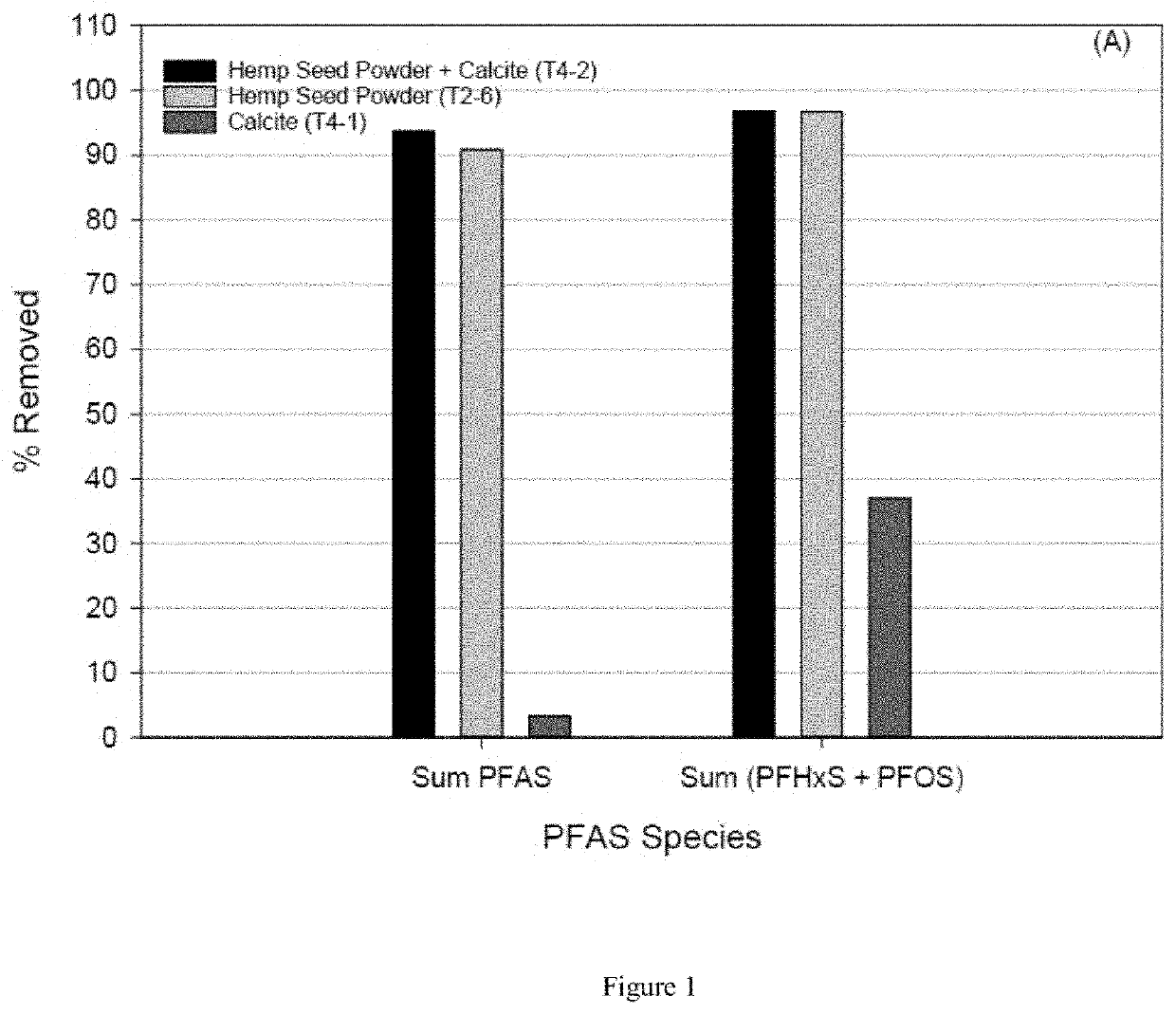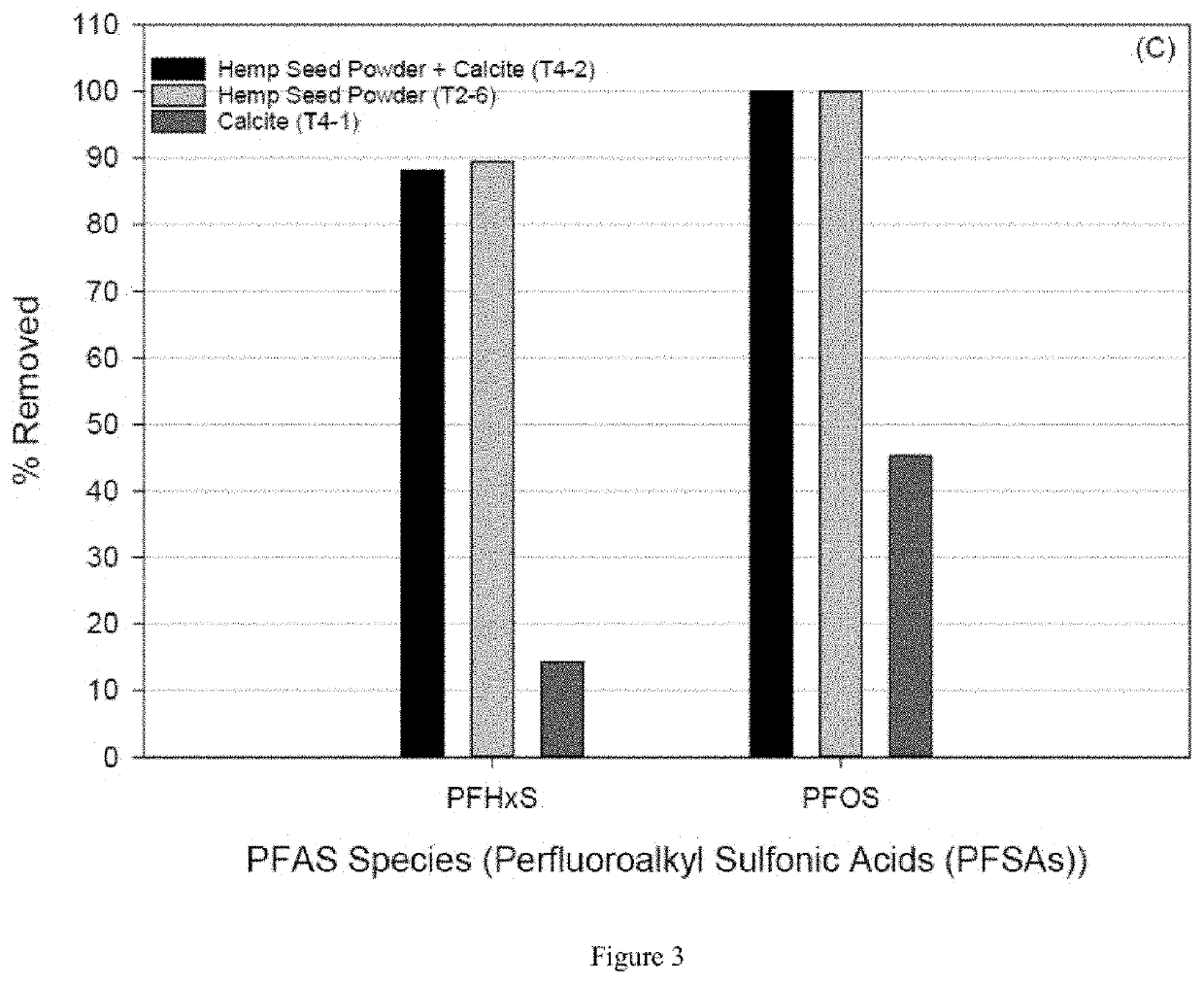An adsorbent
a technology of adsorbents and water, applied in the field of adsorbents, can solve the problems of difficult and expensive remediation of pfas contamination, significant remediation challenge, and many conventional approaches to treating pfas in water, and achieve the effect of improving features and properties
- Summary
- Abstract
- Description
- Claims
- Application Information
AI Technical Summary
Benefits of technology
Problems solved by technology
Method used
Image
Examples
example 1
[0084]Two samples (A & B) of approximately 1 litre were obtained from water flowing out of the drains under Medowie Road from RAAF Williamtown into Moor's Creek in NSW, Australia. The samples were placed in a cooler bag with ice bricks for transport to the University of Newcastle Geoenvironmental laboratories.
[0085]Sample A was spiked with analytical grade (Sigma Aldrich) perfluorooctanoic acid (PFOA) whilst sample B was combined 1:1 with sample A to form sample C. Sample C was then split equally to form sample D to which enough KCl was added to increase the ionic strength to ˜45 mS / cm. The samples were stored at 4° C.
[0086]A set of batch reactor samples were setup to determine the extent of PFAS removal using five different sorbents (S1-S5). Batch tests were done in PFAS approved plastic ware, capped and left for at least 3 days in an end-over-end stirrer to equilibrate. Blanks were included in each batch test using De-Ionized (DI) water and DI water made up to ˜45 mS / cm with KCl. ...
example 2
[0106]Approximately 50 L was obtained from monitoring well MW187s at Williamstown RAAF Base, NSW, Australia. Table 3 lists the major PFAS analytes and concentrations of this sample as determined by ALS laboratories, Sydney, NSW, Australia. The term PFAS is used to describe all per- or polyfluoroalky species, which can be divided into subclasses and individual species as shown in Table 2.
TABLE 3Major PFAS analytes found in ground water frommonitoring well (MW) 187 as used in Example 2.Analyte GroupingAnalyteMW187sPerfluoroalkanePFOS91.7SulfonatesPFHxS20.7(PFSAs)PFBS3(μg / L)ΣPFOS + PFHxS112PerfluoroalkylPFOA4.3CarboxylatesPFHxA6.3(PFCAs)PFHpA2.18(μg / L)PFBA3.3Fluorotelomers6:2 FTS(μg / L)ΣPFAS (TOTAL)194
[0107]An experimental methodology as provided in Example 1 was followed wherein soy protein isolate powder (SPI) (natural; sourced from a health food store) is compared to removal using hemp seed powder (HSP). Experiments using groundwater from MW187s were conducted on both protein powders...
example 3
[0111]Groundwater from monitoring well MW 187s was diluted by volume to achieve a concentration of 10%, 25%, 50% and 100% (undiluted) of the initial groundwater according (Table 3). Sorption isotherms were then developed for HSP and SPI at a solid to liquid ratio of 100 g / L.
[0112]The adsorption distribution coefficient (K4) is used environmentally to estimate the removal of a contaminant during treatment with a given sorbent material. Kd is determined from the analysis of a sorption isotherm where the amount of contaminant removed per mass of sorbent (Cs; μg / kg) is compared to the final concentration of containment in solution (Cs; μg / L). Accordingly, Kd is expressed in units of L / kg.
[0113]For a linear relationship Cs=KdCe with high Kd values indicating that the sorbent has a high affinity for the containment. Other sorption isotherms relationships exist such as the Freundlich or Langmuir isotherm but these describe non-linear contaminant sorption. In the experiments presented herei...
PUM
| Property | Measurement | Unit |
|---|---|---|
| Temperature | aaaaa | aaaaa |
| Temperature | aaaaa | aaaaa |
| Temperature | aaaaa | aaaaa |
Abstract
Description
Claims
Application Information
 Login to View More
Login to View More - R&D
- Intellectual Property
- Life Sciences
- Materials
- Tech Scout
- Unparalleled Data Quality
- Higher Quality Content
- 60% Fewer Hallucinations
Browse by: Latest US Patents, China's latest patents, Technical Efficacy Thesaurus, Application Domain, Technology Topic, Popular Technical Reports.
© 2025 PatSnap. All rights reserved.Legal|Privacy policy|Modern Slavery Act Transparency Statement|Sitemap|About US| Contact US: help@patsnap.com



